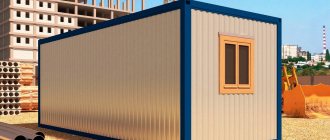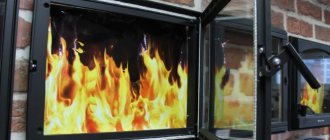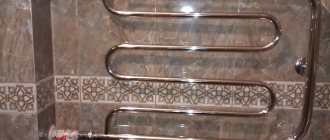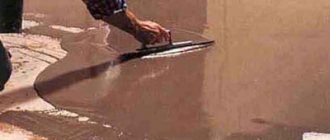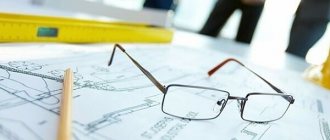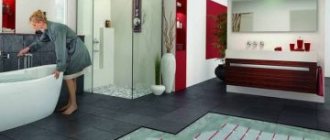Effective and reliable materials for thermal insulation of loggia floors include loose expanded clay and tile extruded polystyrene foam Penoplex. They are installed under any floor covering: concrete screed, wooden floor, parquet, linoleum, ceramic tiles, carpet, laminate.
These insulation materials have low thermal conductivity, are easy and quick to install, and have an affordable price. The only thing that distinguishes them is the method of installation on the loggia floor: expanded clay is placed in bulk in the spaces between the sheathing, and Penoplex is attached to the base with panels of different thicknesses.
What is the best way to insulate a floor under a screed? We understand the choice of optimal material
Since about 30% of all heat loss occurs through the floor, it needs insulation in the same way as other structural elements of the room - walls and ceiling.
The main method of thermal insulation is insulating the floor under the screed. When insulating under a screed, it is very important to choose the right thermal insulator. Insulation materials such as expanded clay, polystyrene foam, mineral wool, penoplex and polyurethane foam are most often used as insulation for installing a heat-insulating layer under screed. You can also install a floor heating system, which can be infrared, electric or water.
Insulation with mineral wool
Mineral wool has high sound insulation properties. Due to the high hygroscopicity of the insulation, the mineral wool thermal insulation layer must be completely isolated from contact with moisture.
Technology of floor insulation with mineral wool mats
Before installing mineral wool mats, it is necessary to remove the old floor covering
Before installing mineral wool mats, it is necessary to remove the old floor covering, clean the floor from existing contaminants, cover cracks and crevices, then lay a waterproofing film, mineral wool mats and a vapor barrier membrane. Clamps are installed on top of the structure in order to provide the necessary ventilation gap, and a reinforcing mesh of 3 mm wire is mounted on top of the clamps.
A leveling concrete screed is applied on top of the reinforcing mesh. If significant static and dynamic loads will not act on the floor, then the concrete screed can be lightened by adding expanded clay to it.
Penoplex screed - what kind of technology is it?
Penoplex boards have good density and strength; they are not afraid of high loads. Both sand and cement screed and self-leveling mixtures fit well on their flat surface.
Its homogeneous structure is similar to a whole arsenal of small cells measuring 0.2 mm in size. Unlike other insulation materials, it has virtually no vapor permeability and does not absorb moisture. Penoplex is produced by industry mainly in the form of rectangular slabs of different lengths, widths, and thicknesses.
For insulation, you can use not only slabs, but also polystyrene granules, which are sold in bags. Granules are added to the concrete solution to produce polystyrene concrete. But it is more convenient to use penoplex in slabs under floor screed for insulation.
An uninsulated floor leads to increased humidity in the house, which results in the appearance of fungal mold. The room loses up to 20% of heat through cold floors. People suffer from colds and leg joints suffer.
Before insulating floors with foam boards, you need to prepare the base. The concrete base is freed from dirt, potholes and irregularities are repaired. The earthen base is first covered with a sand cushion, and before screeding it is compacted and leveled.
Pros and cons of floor insulation under screed
Compared to other insulation materials, the manufacturing technology of tile penoplex is aimed at protecting the material from moisture absorption. Its closed cell structure gives the material frost resistance and compressive strength.
Penoplex on the floor under the screed has the following advantages:
- Expanded polystyrene boards are not subject to combustion, do not emit toxic fumes, are not afraid of high humidity, and do not wear out or rot for a long time. Their service life is determined to be 50 years.
- The material is endowed with a high thermal conductivity coefficient. Its value is 0.030 W/(m*C), which indicates its good thermal insulation properties. The vapor permeability coefficient is 0.007-0.008 mg/(m*hour*Pa). Its low vapor permeability is comparable to roofing felt.
- The high strength of the material allows you to place heavy pieces of furniture on it without fear of squeezing.
- The slabs are well cut to the required dimensions and are easy to install.
- The porous structure of penoplex gives the slabs light weight.
- Weather conditions do not interfere with working with the material.
Important! Penoplex panels do not lose their thermal insulation and other qualities throughout their entire service life.
The disadvantages of penoplex products include their high price, strong smoke during smoldering, and the fact that they are destroyed under the influence of chemical solvents and high temperatures.
Dry screed with expanded clay
- If the subfloor is made of concrete, it must be insulated from moisture. To do this, lay a thick plastic film, preferably in one piece; but if its width is not enough, overlap the strips by 20 cm and glue the joints with tape. The film sides should rise along the perimeter of the walls. Their height should exceed the total thickness of the screed and floor covering.
- A damper tape is laid along the perimeter of the walls. It is used to compensate for the expansion of materials, preventing arbitrary opening of the floor and their deformation due to increased air temperature.
- In order to spread expanded clay in an even layer, beacons are used. It should be noted that beacons that are used under concrete mixture are not suitable, since they are not high enough. Usually take guides at least 3 cm high and attach them to the floor with mortar. Expanded clay is poured between the guides and the surface is leveled with a wooden rule. As a standard installation of a new expanded clay floor, the floor rises by 6-8 cm. This value includes the height of all materials, including the top slabs.
How to cover expanded clay?
The bulk material is covered with slabs of plywood, chipboard, OSB, gypsum fiber board. Of these, the most popular are gypsum fiber sheets (GVL). They are laid in 2 layers. The reverse side is first coated with special glue for gypsum plasterboard. A good option if the sheets have folds along the edge of the perimeter. They allow you to join them tightly, without gaps. The folds are also coated with glue.
Laying the slabs begins from the corner near the window and moves towards the door. At the same time, make sure that the seams of each next row are spaced apart from the adjacent ones. It resembles brickwork. Upon completion of work, any finishing coating is laid.
Forced insulation of a finished wooden floor
A cold floor in a room does not leave a pleasant impression and sometimes you have to insulate it.
To do this you need:
- Remove the baseboards around the perimeter of the room.
- Carefully, without damaging, remove the finishing boards. Number them in order of location, remove the nails.
- Remove the subfloor.
- If necessary, add expanded clay just above the bottom level of the joists, carefully level it and tamp it down.
- Cut penoplex plates according to the distance between the joists and along the length of the room.
- Lay the first layer, seal the joints with tape.
- Lay the second layer in the same way, ensuring that the joints overlap. Tape the joints.
- Restore the subfloor.
- Lay the finishing coating, installing the boards according to the numbering in reverse order.
- Nail the baseboards.
In this case, we recommend using plates with a minimum thickness of 20 mm in two layers. This is enough to successfully resolve the issue.
Useful article? Add to your bookmarks!
Options for thermal insulation materials
The result of the work depends, first of all, on the quality of the materials. When assessing the positive qualities of thermal insulation and the thermal conductivity coefficient of different materials, one should not forget that natural and synthetic materials have different technical characteristics, on which the quality of work and the quality of the thermal insulation itself depend. Among the most popular materials today, it is worth highlighting insulation made from natural materials - mineral wool, expanded clay, glass wool. And artificial materials - polystyrene foam, extruded polystyrene foam, polyurethane foam. These insulation materials are quite widely represented on the market, however, in order to select the right material you need to know the basic characteristics of the material.
Expanded polystyrene
Expanded polystyrene or polystyrene foam consists of granules bonded together during the manufacturing process. Density is a qualitative indicator of a material. The higher the density of expanded polystyrene, the higher its thermal insulation qualities. Expanded polystyrene is produced in slabs with a thickness of 20 to 50 mm. The main application is thermal insulation of buildings and communications. The material is lightweight and does not absorb water. However, among the disadvantages it is worth noting that mice often settle in the thickness of the foam. It is flammable, so you need to be careful when installing. To insulate the floor on the ground, material with a high density is used, low density is used for installation on walls and ceilings. For the floor, slabs with locking joints at the ends are used.
Walls
Insulation of external walls is extremely rarely carried out separately. After all, it will then lead to improper distribution of heat throughout the material. The walls, floor and ceiling will warm up first, and only then will the air temperature begin to rise. This, of course, is not at all what is expected from a quality bath.
Formally, there is no need for a counter-lattice. But any experienced craftsmen install it to make it easier and faster to create a ventilation duct. The wood must be impregnated with an antiseptic. If installation is on a brick wall, it is advisable to use dowels; they compensate for the excessive rigidity of the structure and speed up installation. Foamed glass is technically perfect, but it turns out to be too expensive to use.
Penoplex
Penoplex, which is often called extruded polystyrene foam, has high strength, resistance to deformation and rotting, water resistance, environmentally friendly composition and the absence of toxic substances. Using penoplex as insulation can significantly reduce energy costs and save on the purchase of additional heating devices.
With high-quality installation, penoplex can provide ideal thermal insulation properties.
To lay penoplex, the soil is leveled with gravel, thoroughly compacted and covered with a layer of compacted sand. Then a rough base is created from reinforced concrete, which is left to dry for a week, after which a waterproofing layer is laid on it, and penoplex is placed on it. Penoplex is covered with another layer of waterproofing and filled with concrete screed.
Organization of floor heating by installing a “warm floor” system
When installing a heated floor system, it is necessary to install a waterproofing layer, then lay insulation (penoplex, polyurethane foam, polystyrene foam, mineral wool mats), cover the structure with aluminum foil, which will act as a heat shield that reflects thermal energy, install the “warm floor” system (lay pipes or electric mats), complete the finishing fill and lay the selected floor covering.
We recommend that you first watch the video below to clearly understand how this happens:
Semi-dry and dry screed
Dry screed gets its name due to the fact that liquid cement-sand mixtures are not used at all in its construction.
In essence, the creation of such a screed is the filling of expanded clay as insulation and filler between the joists of the subfloor.
The technology for laying dry screed consists of laying waterproofing, damper tape and backfilling the expanded clay itself. The base of the subfloor is laid on top of the dry screed. GVL sheets are most often used as such.
Dry expanded clay screed can be covered only with materials that can withstand moisture, withstand severe mechanical loads and not crumble. Therefore, the use of chipboard, plywood, etc. is strongly not recommended.
A semi-dry screed is a cross between a regular cement-sand screed and a dry expanded clay screed. The meaning of this option is to pour expanded clay onto a rough base (as in the case of a dry screed), followed by pouring concrete.
This solution is convenient due to the absence of the need for thorough preparation of the subfloor and lower consumption of central fiber. However, it is worth considering that in terms of its ability to withstand loads, a semi-dry expanded clay screed is much inferior to the “wet” version.
Preparatory work
Before insulating the floor, it is necessary to prepare the base. Since the base can be of 2 types: concrete and wood, the instructions for preparing them are different.
Preparing the concrete base
To obtain highly effective thermal insulation in an apartment, the subfloor must be prepared. The work is performed in the following sequence:
- the old screed is dismantled using a hammer drill;
- construction waste is removed;
- the surface is swept and then washed with a damp cloth (you can, if you have a construction vacuum cleaner, but not at home; do not wash the concrete floor, but vacuum it);
- a thorough inspection of the floor is carried out, during which cracks, holes and other defects are identified;
- the seam between the slabs is sealed with repair mortar in two steps, since during the setting process the first layer will sag in any case;
- Cracks and chips are repaired. The technology for repair work is described in detail in the article “Preparing the floor for pouring screed.”
Large cracks are reinforced. After the repair mortar has completely set, the concrete base is primed in 2 layers with cement laitance or a deep penetration primer (“Ceresit ST 17”).
When to choose expanded clay
The range of heat-insulating materials on the modern market is so large that it can be difficult to settle on just one. However, it is worth learning the full range of properties of this unique material in order to understand that there is no better option than to insulate the floor with expanded clay.
A list of properties that make this simple material a leader among its competitors:
- Low thermal conductivity - the porous material contains air bubbles, which provide high-quality thermal insulation. A 10 cm layer of expanded clay exceeds the thermal conductivity parameters of a similar wooden surface by 3 times, and brickwork by 10 times.
- Sound insulation is a property that is in demand in apartments of multi-storey buildings; the expanded clay floor will serve as a reliable barrier to the penetration of noise from neighbors below, while simultaneously preventing the spread of sounds in the opposite direction.
- The strength of the material allows it to be used in the bottom layer of the floor pie without additional supporting structures (expanded clay is available in different grades of strength from 250 to 600).
- Resistance to rot and fungi, mold (unlike wood-based materials) increases the service life of the floor and its durability.
- Chemical inertness - expanded clay is a natural material, does not release any substances into the environment, and is also resistant to chemicals.
- Heat resistance - quality is important in terms of fire safety.
- Frost resistance - expanded clay does not lose its properties at extremely low temperatures.
- Light weight - allows you to insulate the floor with expanded clay under a screed in houses where a large load on the floors is undesirable (read: “Insulating the floor under a screed - practical tips”).
- The granular fraction of the material makes it easy to work with - one person who does not have construction skills can handle the backfill.
- Low cost is an additional bonus for a material that has a range of excellent qualities.
The only disadvantage of expanded clay is its ability to retain moisture for a long time. This drawback can be easily mitigated by following the technology of installing a floor with expanded clay and carefully gluing the waterproofing layer.
Advice from professionals
When insulating a balcony with expanded clay, you must use a protective mask or respirator to protect your respiratory tract from dust. The most dense layer of material is obtained from a mixture of all three fractions, but you need to keep in mind that a large amount of sand will increase the weight of the insulation and, consequently, the load on the balcony floor. Ordinary polyethylene film can be used as a waterproofing material.
If several strips of film are used, they must be laid with an overlap of 10-15 cm
There are standards for constructing large area screeds. You cannot fill large areas of the floor at once. If the floor on the balcony has an area of more than 25 square meters. m, you should divide it into sections and work with each contour separately. This will make the process easier and protect against possible problems with insulation.
A layer of concrete is leveled from the outer wall of the balcony to the door
To achieve good insulation, the layer thickness must be at least 10 cm. A screed of such thickness is difficult to level and takes a long time to dry. If the concrete thickness exceeds 6 cm, it is recommended to fill it in two stages: the first layer is 4-5 cm below the level of the future balcony floor, the second layer is the final leveling. When pouring multi-layers, it is advisable to apply the second layer immediately after the main one so that the screed is uniform. A rule (a tool for leveling the floor) can be made from a piece of flat and strong board.
According to building codes, when preparing a floor for laying linoleum or laminate, the clearance between a two-meter lath and the surface of the concrete screed should not exceed two millimeters. To check the quality of the screed, just take any flat plank, lay it on the floor with the end of the long side and evaluate the gap between the plank and the floor. For convenience, you can place a light source behind the rail, for example, put a switched-on flashlight on the floor.
Types of expanded polystyrene
In stores and markets, polystyrene foam is sold in rectangular slabs and in the form of granules. Both options can be used to insulate the floor under the screed. The second option is used to prepare polystyrene concrete - a concrete solution that contains insulation. Depending on the characteristics of production, I divide the material into two categories - polystyrene foam and extruded polystyrene. The raw materials used in both cases are the same, but the manufacturing process is different.
Polystyrene foam is made of foam granules filled with air. And although they are connected, there is an air space between them, into which moisture can enter. In this case, the characteristics of the material deteriorate. In addition, the risk of destruction increases.
When making extruded polystyrene, the foam mass is passed through a special apparatus called an extruder. As a result, the insulation has a completely different structure. It consists of closed pores into which moisture does not penetrate. Thanks to this, extruded polystyrene foam is superior to polystyrene foam in thermal insulation and other characteristics, but it is more expensive. This is due to the fact that more expensive equipment is used for production.
When choosing, it is advisable to give preference to a heat insulator that has passed through an extruder, since it is stronger and more durable, but at the same time retains heat better. In any case, ask the seller for quality certificates.
We do the insulation of a bathhouse from the inside with our own hands: what and how, different bathhouses need to be insulated differently
Home page » What is the best material to build a bathhouse from » Insulation of a bathhouse » We do the insulation of a bathhouse from the inside with our own hands: what and how, different bathhouses need to be insulated differently
Insulation may be required either by a new, just built bathhouse, or by an already used one, but requiring modernization or repair.
You can contact a specialized company that provides such services, paying for both materials and installation services. Or you can insulate the bathhouse from the inside with your own hands, thereby saving on the cost of services. But our article is intended to help and understand all the intricacies and intricacies.
How to make an insulated dry screed
The advantage of dry screed is that it is easier and faster to make than cement-sand screed. Insulation of floors under dry screed has some peculiarities. Materials for dry screed, as a rule, deteriorate from high humidity.
For example, gypsum fiber sheet, a very common material, does not tolerate moisture, as it increases in size and loses its properties. Therefore, the presence of a dew point on the surface or inside the dry screed is not allowed.
Of course, the screed acts as a layer of interior finishing, and the dew point can only be found on it with very unsatisfactory insulation and cold floors. Let's take a closer look at how to insulate floors under dry screed so that they last a long time and the house is comfortable.
Design of floor insulation under dry screed
The base of the subfloor can be anything. Common: reinforced concrete floors over the basement, over the underground, floors on the ground, or wooden floors over the ventilated underground.
Criteria for choosing insulation for a balcony
Balcony slabs, due to the way they are attached to the building, have a smaller margin of safety than loggia floors. Therefore, when arranging balconies, it is necessary to strive to ensure that the load on the slab at the end of the repair is as close as possible to the design one, or the site must be additionally strengthened.
Thus, when deciding on the method of finishing the balcony, you need to take into account the specific gravity of the materials used, including insulation.
In addition to acceptable weight, the selection criteria are also safety, efficiency and durability - parameters that depend on the individual characteristics of the insulating material.
